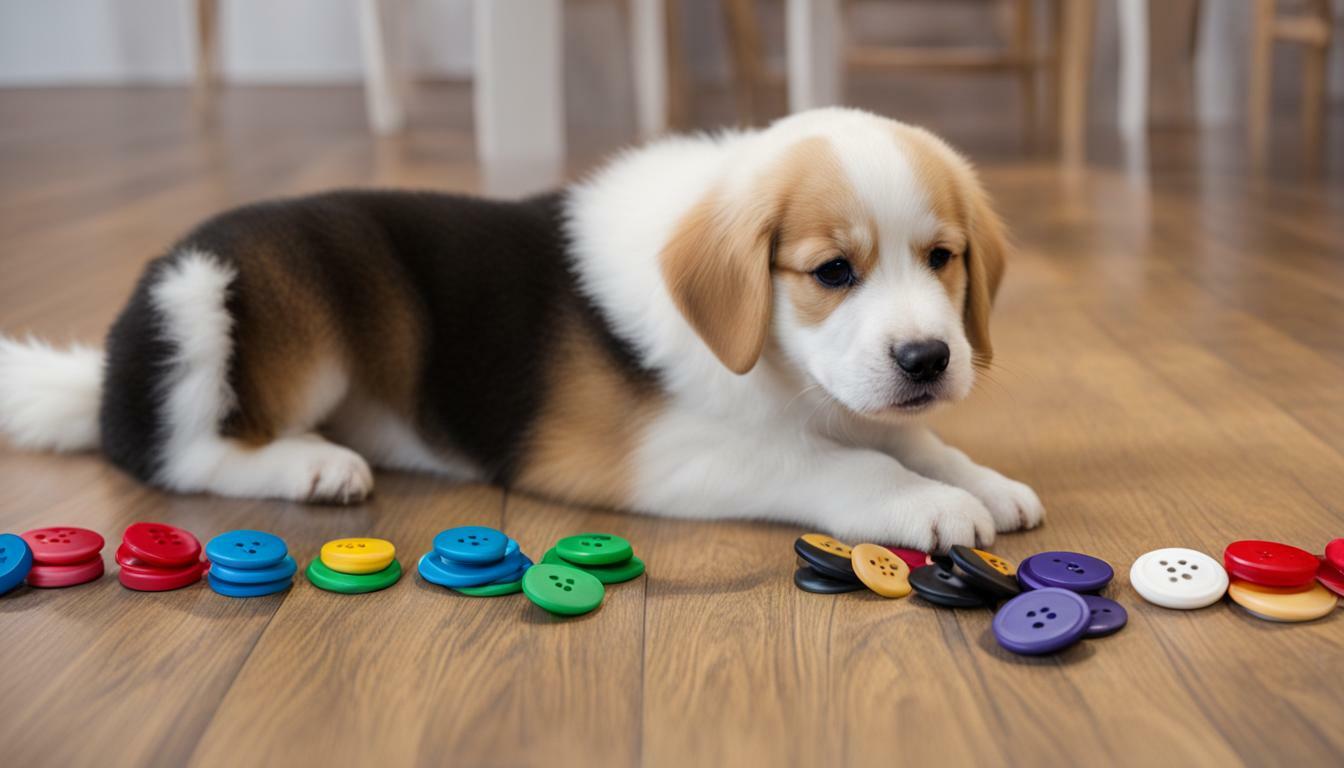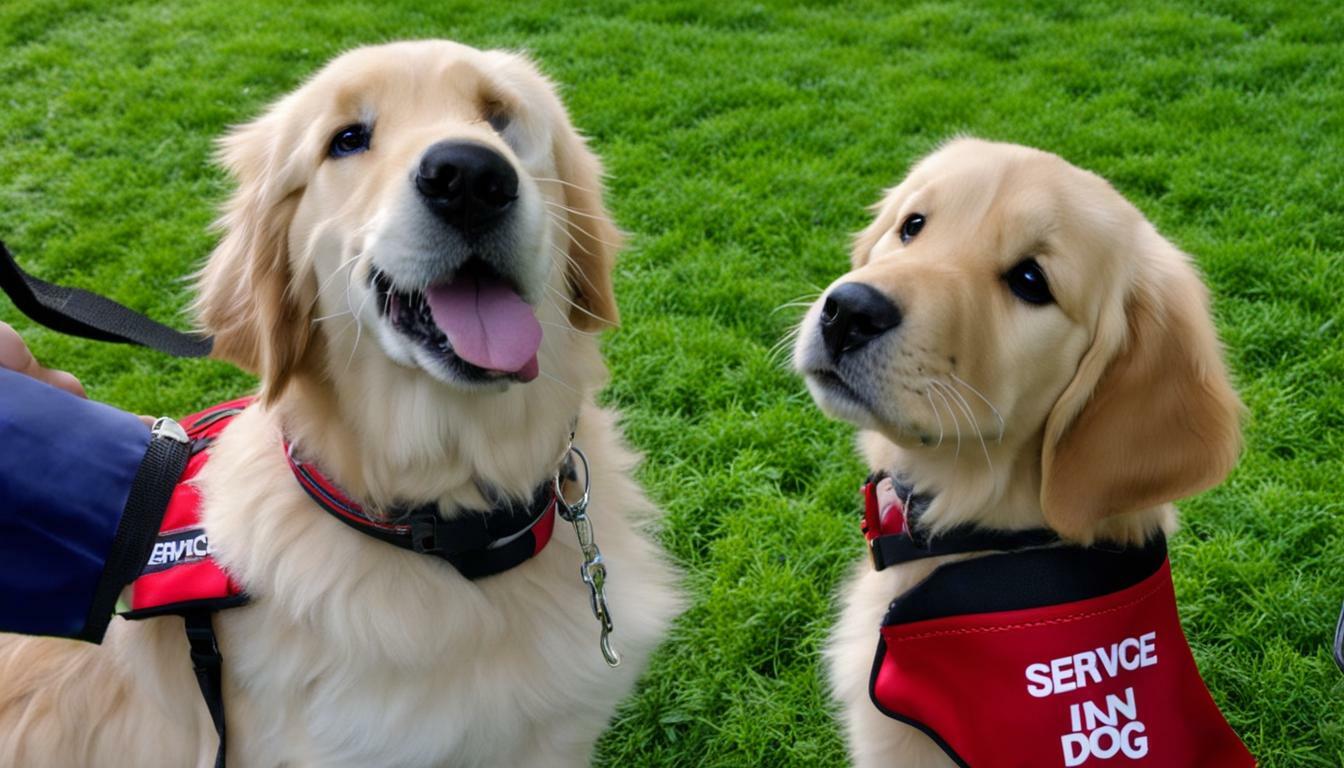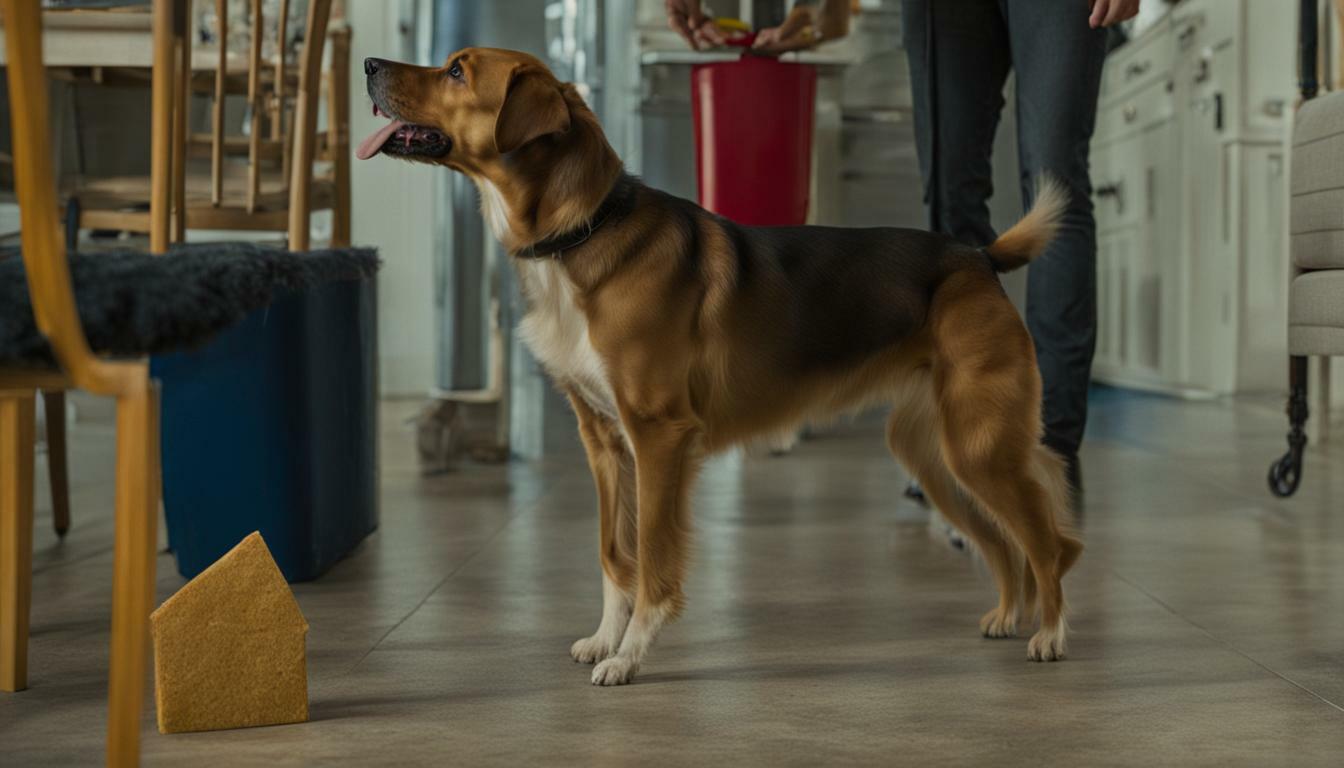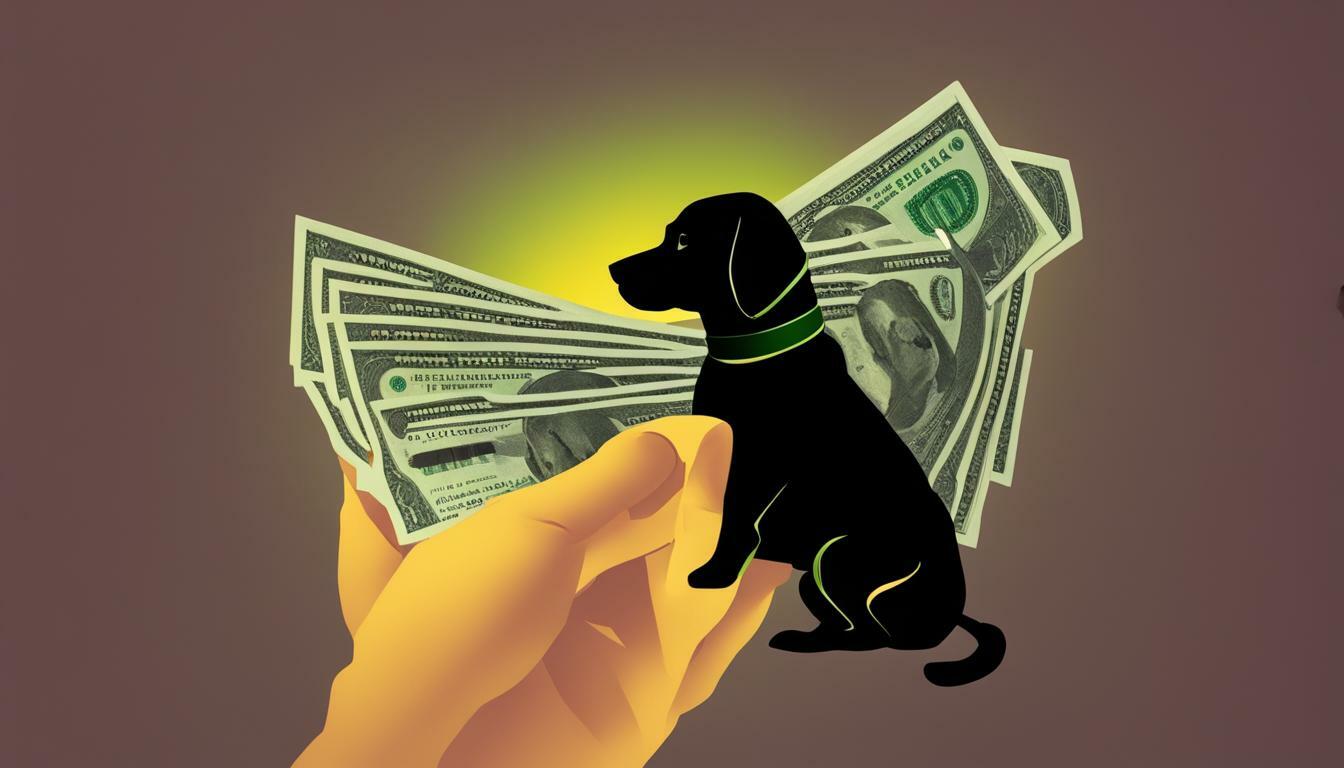Training a dog not to attack rabbits requires patience, consistency, and positive reinforcement techniques. It can be a challenging process, but with the right strategies, you can successfully train your dog to coexist peacefully with rabbits. Here are some tips to help you on your training journey:
Key Takeaways:
- Desensitize your dog to the presence of rabbits by gradually exposing them to a toy rabbit or similar object.
- Teach your dog the ‘Sit’ command and use it to redirect their focus when approaching a rabbit.
- Use the auditory deterrent of a rock bottle to discourage your dog’s chasing behavior towards rabbits.
- Reinforce positive behavior by rewarding your dog with treats and praise when they ignore rabbits.
- If needed, seek professional help from a trainer experienced in working with dogs with high prey drive.
Understanding Dog Behavior Towards Rabbits
Before training your dog not to attack rabbits, it’s essential to understand their natural instincts and establish a solid foundation of obedience training. Dogs have an inherent prey drive, which makes them instinctually inclined to chase small animals like rabbits. This behavior can be managed and modified through proper training techniques.
One of the key aspects of obedience training is teaching your dog impulse control. This involves teaching them commands like “sit” and “stay” to redirect their focus and prevent impulsive behaviors, such as chasing rabbits. Consistently reinforcing these commands will help your dog understand that they need to listen to you and follow your instructions, even when faced with tempting distractions like rabbits.
Recognizing the Signs
To effectively prevent dog attacks on rabbits, it’s crucial to recognize the signs of heightened prey drive in your dog. These signs may include intense focus on the rabbit, raised ears, a rigid body posture, and a high tail wag. By identifying these signs early on, you can intervene and redirect your dog’s attention before they engage in chasing behavior.
Additionally, dogs with a strong prey drive may benefit from desensitization training. This involves gradually exposing your dog to rabbits in a controlled environment, using a toy rabbit or similar object. Start at a safe distance and reward your dog for ignoring the rabbit. Over time, gradually decrease the distance to the rabbit, allowing your dog to become more comfortable in their presence without reacting.
By understanding your dog’s natural instincts and implementing obedience training techniques, you can effectively prevent dog attacks on rabbits. Remember to be patient, consistent, and always reward good behavior. With time and practice, you can train your dog to coexist peacefully with rabbits.
Desensitization Training
Desensitization training is a highly effective method to teach dogs to remain calm and ignore rabbits in their environment. By gradually exposing your dog to the presence of rabbits using a toy rabbit or similar object, you can help them overcome their natural prey drive and develop a more controlled response.
Start the training at a safe distance from the rabbit, where your dog can see it but not react strongly. Reward your dog with treats and praise for remaining calm and ignoring the rabbit. Slowly decrease the distance between your dog and the rabbit, continuing to reward them for good behavior.
It’s important to be patient during the desensitization process, as it may take time for your dog to learn to ignore the rabbits. Consistency is key – practice the training regularly to reinforce the desired behavior. Over time, your dog will become more comfortable being near rabbits without feeling the need to chase or attack.
| Desensitization Training Steps: |
|---|
| 1. Introduce the toy rabbit to your dog at a safe distance. |
| 2. Reward your dog for remaining calm and ignoring the rabbit. |
| 3. Gradually decrease the distance between your dog and the rabbit. |
| 4. Continue rewarding your dog for good behavior throughout the training. |
Through desensitization training, you can help your dog develop self-control and learn to coexist peacefully with rabbits. Remember to always prioritize the safety of both your dog and the rabbits, and seek professional help if needed.
Teaching the ‘Sit’ Command
The ‘sit’ command is a powerful tool in redirecting a dog’s attention and controlling their impulse to chase rabbits. It provides a foundation for obedience and helps establish your control over your dog’s behavior. Follow these steps to teach your dog the ‘sit’ command:
- Start in a quiet and distraction-free area. Hold a treat close to your dog’s nose, and then slowly move your hand up, prompting them to follow the treat with their gaze and nose.
- As your dog’s head moves up, their rear end will naturally lower. At this point, say “sit” in a clear and firm voice.
- Once your dog is in a sitting position, reward them by giving them the treat and praising them. Use positive reinforcement, such as saying “good job” or giving them a pat on the head.
- Repeat this process several times, gradually reducing the use of treats and relying more on verbal and physical praise. Practice the ‘sit’ command in different locations and gradually introduce distractions, such as the presence of a toy rabbit or the sound of a squeaky toy.
By consistently practicing the ‘sit’ command, you can gain greater control over your dog’s behavior when they encounter rabbits. Remember to always be patient and use positive reinforcement to encourage your dog’s progress.
| Benefits of Teaching the ‘Sit’ Command | How to Teach the ‘Sit’ Command |
|---|---|
|
|
Remember, consistency is key when training your dog. Regular practice, positive reinforcement, and patience will help your dog learn and overcome their natural prey drive towards rabbits.
The Rock Bottle Technique
The rock bottle technique can be an effective way to discourage a dog from chasing rabbits by using an auditory deterrent. This technique involves creating a bottle filled with rocks or pebbles and shaking it when your dog shows interest in a rabbit. The loud noise produced by the shaking bottle can startle the dog and interrupt their chasing behavior. It serves as a reminder that chasing rabbits is not desirable.
To use the rock bottle technique, start by assembling a plastic bottle and filling it with rocks or pebbles. Make sure the bottle is securely closed to prevent the rocks from falling out. When you see your dog exhibiting interest in a rabbit, give the bottle a firm shake. The sudden noise will grab their attention and discourage them from continuing the chase.
It’s important to note that the rock bottle technique should be used as a supplemental training tool alongside other positive reinforcement techniques. It should never be used as a form of punishment or harm to the dog. The goal is to teach the dog that chasing rabbits is not acceptable behavior.
Remember, consistency is key when using the rock bottle technique. Be patient with your dog and continue practicing the technique over time. With proper training and reinforcement, you can help your dog learn to control their natural prey drive and prevent them from attacking rabbits.
| Pros | Cons |
|---|---|
| Provides an auditory deterrent | Should be used in conjunction with other training techniques |
| Easy to implement | Requires consistency and patience |
| Can be effective in interrupting chasing behavior | Not suitable for all dogs |
Positive Reinforcement: A Key Element in Dog Training
Positive reinforcement through rewards and praise is a crucial aspect of training a dog not to attack rabbits. By using this technique, you can encourage your dog to exhibit the desired behavior and discourage their natural prey drive. Here are some tips on how to effectively utilize positive reinforcement:
- Use treats: Reward your dog with small, tasty treats when they display good behavior around rabbits. This creates a positive association and motivates them to repeat the behavior.
- Offer praise: In addition to treats, give your dog praise and verbal affirmations whenever they ignore rabbits or exhibit calm behavior. Dogs thrive on the approval of their owners, and positive reinforcement helps to reinforce this.
- Be consistent: Consistency is key when using positive reinforcement. Make sure to reward your dog every time they demonstrate the desired behavior, whether it’s ignoring a rabbit or staying by your side. This consistency will reinforce the connection between the reward and the behavior, making it more likely to be repeated.
Remember, positive reinforcement does not mean ignoring unwanted behavior. Instead, it means redirecting your dog’s attention to the desired behavior and rewarding them when they follow through. Over time, your dog will learn to associate rabbits with positive experiences and exhibit the desired behavior without the need for constant rewards.
Using Clicker Training for Positive Reinforcement
Clicker training is another effective technique that pairs positive reinforcement with a distinct sound. Here’s how it works:
- Get a clicker: Purchase a clicker device from your local pet store or online. This small, handheld device emits a clicking sound when pressed.
- Associate clicks with rewards: Before introducing the clicker to your dog, establish the association between the sound and rewards. Click the device and immediately give your dog a treat. Repeat this several times until your dog understands that the click signifies a reward.
- Use the clicker during training: Once your dog understands the connection between the click and the reward, incorporate the clicker into your training sessions. Click when your dog exhibits the desired behavior, and follow it with a treat and praise.
| Pros of Positive Reinforcement | Cons of Positive Reinforcement |
|---|---|
|
|
Maintaining Consistency
Consistency is key when training a dog not to attack rabbits, and it helps reinforce the desired behavior consistently. Dogs thrive on routine and predictability, so it’s important to maintain a consistent training schedule and approach. Here are some tips to help you maintain consistency in your dog’s training:
- Establish a training routine: Set aside specific times each day for training sessions with your dog. Consistency in the frequency and duration of these sessions will help your dog understand what is expected of them.
- Use clear and consistent cues: Whether you’re teaching your dog the ‘sit’ command or redirecting their attention away from a rabbit, use the same cues and commands every time. This helps your dog understand what you want them to do and avoids confusion.
- Be consistent with rewards and consequences: When your dog exhibits the desired behavior of ignoring rabbits, reward them immediately with treats, praise, or playtime. Similarly, if they show interest in chasing a rabbit, redirect their attention and use the rock bottle technique as a deterrent. Consistency in rewarding good behavior and addressing unwanted behavior will help your dog understand what is expected of them.
- Involve the whole family: Consistency is essential not just for you but for everyone in your household. Make sure everyone involved in your dog’s training understands and follows the same rules and techniques. This ensures that your dog receives consistent messages and reinforces their training across different environments.
Maintaining consistency can be challenging, especially when faced with distractions or setbacks. However, by staying committed and following through with your training plan, you can help your dog learn to ignore rabbits and prevent potential attacks. Remember to be patient and to celebrate small victories along the way.
Creating a Safe Environment
Establishing a safe environment is crucial for both dogs and rabbits to coexist peacefully and prevent any potential attacks. By taking certain precautions, you can ensure the safety of both your furry friends. Here are some tips to help you create a safe environment:
- Secure enclosures: Provide a secure and well-fenced area for your rabbits to roam freely without the risk of a dog getting in. This will give them the freedom to exercise and explore while keeping them safe.
- Supervised interactions: When allowing your dog and rabbit to interact, always ensure it’s done under close supervision. This way, you can intervene if any signs of aggression or chasing behavior are displayed.
- Separate feeding areas: Dogs have a natural instinct to guard their food, which can result in conflicts with rabbits. To avoid any potential disputes, provide separate feeding areas for your dog and rabbits.
Table: Dog and Rabbit Interaction Guidelines
| Dog Behavior | Rabbit Behavior | Recommended Action |
|---|---|---|
| Aggressive or dominant posture | Signs of fear or distress | Separate the dog and rabbit immediately and seek professional help |
| Chasing or lunging after the rabbit | Running away in fear | Interrupt the behavior and redirect the dog’s attention using the ‘Sit’ command |
| Calm and relaxed body language | Curious and friendly behavior | Continue supervised interactions, rewarding the dog for calm behavior |
By following these guidelines and maintaining a safe environment, you can minimize the risk of dog attacks on rabbits and promote a harmonious relationship between the two. Remember, the safety and well-being of both your dog and rabbit are of utmost importance.
Seeking Professional Help
If you’re having difficulties training your dog not to attack rabbits, consider seeking help from a professional trainer experienced in working with dogs with high prey drive. Training a dog with a strong instinct to chase and attack can be challenging, and a professional trainer can provide the expertise and guidance needed to overcome these challenges.
A professional trainer will assess your dog’s behavior and develop a personalized training plan tailored to your dog’s specific needs. They will have a deep understanding of dog behavior and the techniques necessary to modify your dog’s instinctual response to rabbits.
Working with a professional trainer can also benefit you as the owner. They can teach you effective dog training techniques and help you understand how to communicate with your dog more effectively. This knowledge and understanding will enable you to continue training your dog even after your sessions with the trainer have ended.
| Benefits of Seeking Professional Help: |
|---|
| Expertise in working with dogs with high prey drive |
| Personalized training plan tailored to your dog’s needs |
| Knowledge and understanding of effective training techniques |
| Continued support and guidance throughout the training process |
Remember, seeking professional help is not a sign of failure as a dog owner. It shows your commitment to the well-being of your dog and your dedication to ensuring a safe and harmonious environment for all, including rabbits. With the assistance of a professional trainer, you can increase the chances of successfully training your dog not to attack rabbits.
Managing Expectations
It’s important to have realistic expectations and understand that training a dog not to attack rabbits requires time, patience, and consistency. Dogs have natural instincts, and it takes effort to modify their behavior. Here are a few key points to keep in mind:
- Consistency is key: Dogs thrive on routine and repetition, so it’s important to be consistent with your training methods. Use the same commands, rewards, and techniques every time, and make sure all family members are on the same page.
- Progress takes time: Changing a dog’s behavior doesn’t happen overnight. Training requires gradual progress, with small steps forward. Celebrate every success, no matter how small, and stay patient as you work towards your ultimate goal.
- Positivity is powerful: Dogs respond best to positive reinforcement, so focus on rewarding good behavior rather than punishing bad behavior. Treats, praise, and playtime can all be used as rewards, creating a positive association with appropriate behavior around rabbits.
- Professional help can make a difference: If you’re struggling with training or have a dog with a strong prey drive, seeking professional help is a great option. A professional trainer can provide expert guidance, tailor training techniques to your specific dog, and accelerate the training process.
By managing your expectations and following these tips, you can help your dog learn to coexist peacefully with rabbits. Remember that every dog is unique, and the training process may vary. Stay committed, be patient, and soon you’ll see the progress you desire.
| Key Points: | |
|---|---|
| Consistency | Be consistent with your training methods. |
| Time | Changing a dog’s behavior takes time and gradual progress. |
| Positivity | Use positive reinforcement to reward good behavior. |
| Professional Help | Consider seeking professional assistance for guidance and support. |
Keeping Rabbits Safe
When training a dog not to attack rabbits, it’s essential to take necessary precautions to ensure the safety of the rabbits involved. Here are some tips to help you keep rabbits safe during the training process:
- Create a secure enclosure: Provide a safe and enclosed area for the rabbits to live in. This can be a hutch or a fenced-in space where they can move freely without the risk of being chased or attacked by the dog.
- Supervise interactions: When introducing the dog to the rabbits, always keep a close eye on their interactions. Monitor the dog’s behavior closely, and if any signs of aggression or prey drive are observed, immediately redirect their attention and separate them from the rabbits.
- Use barriers: If necessary, use barriers such as gates or fences to create physical separation between the rabbits and the dog. This can help prevent any unintended contact or interactions that could lead to the dog chasing or attacking the rabbits.
By implementing these safety measures, you can ensure the well-being of the rabbits while training your dog not to attack them. Remember, it’s always better to prioritize the safety of all animals involved and take proactive steps to prevent any harm or stress.
| Safety Tips | Description |
|---|---|
| Create a secure enclosure | Provide a safe and enclosed area for the rabbits to live in, away from the dog’s reach. |
| Supervise interactions | Keep a close eye on the dog and rabbit interactions, ensuring the dog does not display any aggressive behavior towards the rabbits. |
| Use barriers | Use gates or fences to physically separate the dog and rabbits when necessary, preventing any unwanted contact. |
By implementing these safety measures and closely monitoring the interactions between your dog and rabbits, you can create a safe and controlled environment that minimizes the risk of any harm to the rabbits involved. Remember to prioritize the well-being of both animals and seek professional help if needed to ensure the training process is smooth and successful.
Conclusion
Training a dog not to attack rabbits requires dedication, but with patience, consistency, and positive reinforcement, it is an achievable goal.
Desensitization is a crucial technique in this training process. Gradually introducing your dog to the presence of rabbits using a toy or similar object helps them learn to ignore the temptation to chase. By rewarding your dog for ignoring the rabbit and reducing the distance over time, you can teach them to stay calm when in the presence of rabbits.
Another effective strategy is using the ‘Sit’ command. Teaching your dog to sit and stay before approaching a rabbit helps redirect their focus and control their chasing instinct. This command gives them a clear instruction and helps establish boundaries.
The rock bottle technique can be used as an auditory deterrent. When your dog shows interest in a rabbit, shaking a bottle filled with rocks or pebbles creates a startling sound that discourages their chasing behavior. This technique helps them associate rabbits with an unpleasant sound, further reducing their desire to chase.
Positive reinforcement plays a vital role in training. By rewarding your dog with treats and praise when they exhibit good behavior and ignore rabbits, you reinforce the desired behavior and encourage them to continue behaving appropriately. This positive association helps strengthen their training and build a strong bond between you and your dog.
If you find yourself struggling with the training process, don’t hesitate to seek professional help. A professional trainer with experience in working with dogs with high prey drive can provide valuable guidance and support to ensure successful training. They can tailor techniques to your dog’s specific needs and help address any challenges that may arise.
Remember, training a dog not to attack rabbits requires time and effort, but with the right approach and consistent training methods, you can create a safe and harmonious environment for both your dog and rabbits.
FAQ
Q: How can I train my dog not to attack rabbits?
A: Training a dog not to attack rabbits can be challenging, but with patience and consistency, it can be achieved. Follow the tips provided in this article to help you train your dog.
Q: What is desensitization training?
A: Desensitization training involves gradually exposing your dog to the presence of rabbits using a toy rabbit or similar object. Start at a safe distance and reward your dog for ignoring the rabbit, gradually decreasing the distance over time.
Q: How can I redirect my dog’s focus when approaching a rabbit?
A: Teach your dog the ‘Sit’ command and use it before allowing them to approach a rabbit. This helps to redirect their focus and control their impulse to chase.
Q: What is the Rock Bottle Technique?
A: The Rock Bottle Technique involves shaking a bottle filled with rocks or pebbles when your dog shows interest in a rabbit. The auditory deterrent can help discourage their chasing behavior.
Q: How should I reward my dog during the training process?
A: Use positive reinforcement by rewarding your dog with treats and praise when they exhibit good behavior and ignore rabbits. This reinforces the desired behavior and encourages them to continue behaving appropriately.
Q: What should I do if I’m struggling to train my dog on my own?
A: If you’re having difficulty training your dog not to attack rabbits, consider hiring a professional trainer who specializes in working with dogs with high prey drive. They can provide guidance and support to help you successfully train your dog.
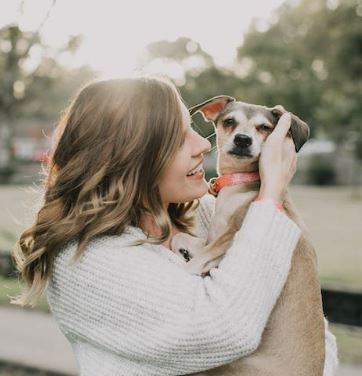
Marissa Delotta, 36, from Dayton, Ohio, is the creative force behind Roverboard.com, a beloved online destination for dog lovers. As a dedicated mom and canine enthusiast, Marissa combines her family experiences with her love for dogs to offer a platform where dog owners can exchange tips, heartwarming stories, and advice. Her website has become a vibrant community for sharing the joys of dog parenting. In her free time, Marissa enjoys exploring dog parks with her family and volunteering at local animal shelters.


